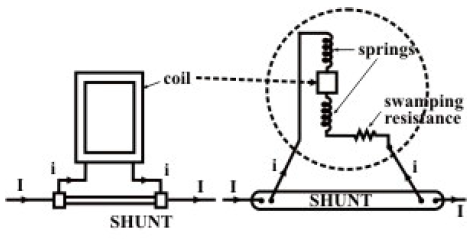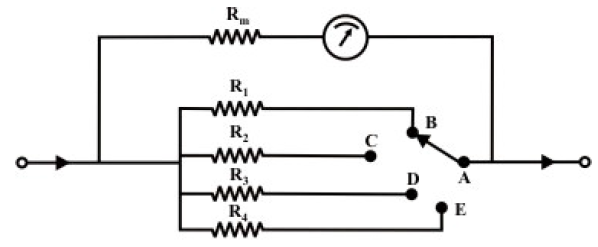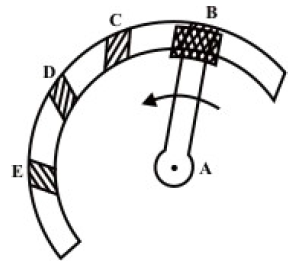A Multi-range Ammeters
A multi-range ammeters: An ammeter is required to measure the current in a circuit and it therefore connected in series with the components carrying the current. If the ammeter resistance is not very much smaller than the load resistance, the load current can be substantially altered by the inclusion of the ammeter in the circuit. To operate a moving coil instrument around a current level 50ma is impractical owing to the bulk and weight of the coil that would be required. So, it is necessary to extend the meter-range shunts (in case of ammeters) and multipliers (in case of volt meters) are used in the following manner.
For higher range ammeters a low resistance made up of manganin (low temperature coefficient of resistance) is connected in parallel to the moving coil (see Fig.A) and instrument may be calibrated to read directly to the total current.
 ................fig (A)
................fig (A)
They are called shunts. The movement of PMMC instrument is not inherently insensitive to temperature, but it may be temperature-compensated by the appropriate use of series and shunt resistors of copper and manganin. Both the magnetic field strength and spring-tension decrease with an increase in temperature. On other side, the coil resistance
increases with an increase in temperature. These changes lead to make the pointer read low for a given current with respect to magnetic field strength and coil resistance. Use of manganin resistance (known as swamping resistance which has a temperature coefficient practically zero) in series with the coil resistance can reduce the error due to the variation of resistance of the moving coil. The swamping resistance (r) is usually three times that of coil thereby reducing a possible error of, say, 4% to 1%. A multirange ammeter can be constructed simple by employing several values of shunt resistances, with a rotary switch to select the desired range. Fig. (B) shows the circuit arrangement.
 fig(b) a multi-range ammeter circuit
fig(b) a multi-range ammeter circuit
When an instrument is used in this fashion, care must be taken to ensure shunt does not become open-circuited, even for a very short instant. When the switch is moved from position ‘B’ to ‘C’ or moved to any positions, the shunt resistance will remain open-circuited for a fraction of time, resulting a very large current may flow through the ammeter and damage the instrument. To avoid such situation, one may use the make-before-break switch as shown in Fig.(c).
 fig(c) make before break
fig(c) make before break
The wide-ended moving contact connected to the next terminal to which it is being moved before it loses contact with the previous terminals. Thus, during the switching time there are two resistances are parallel with the instrument and finally the required shunt only will come in parallel to the instrument.